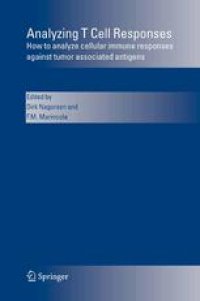
Ebook: Analyzing T Cell Responses: How to Analyze Cellular Immune Responses against Tumor Associated Antigens
- Tags: Immunology, Cancer Research, Hematology, Blood Transfusion Medicine, Virology
- Year: 2005
- Publisher: Springer Netherlands
- Edition: 1
- Language: English
- pdf
Active specific immunotherapy is a promising but investigational modality in the management of cancer patients. Currently, several different cancer vaccine formulations such as peptides, proteins, antigen-pulsed dendritic cells, whole tumor cells, etc. in combination with various adjuvants and carriers are being evaluated in clinical trials (1-3). To determine the optimal cancer vaccine strategy, a surrogate immunological end-point that correlates with clinical outcome needs to be defined, since it would facilitate the rapid comparison of these various formulations. Traditional immunological assays such as ELISA, proliferation and cytotoxicity assays can detect immune responses in vaccinated patients but are not quantitative. In contrast, novel assays such as enzyme-linked immunospot (ELISPOT) assay, intracellular cytokine assay and tetramer assay can quantitate the frequency of antigen-specific T cells. Of these, the ELISPOT assay has the 5 lowest detection limit with 1/10 peripheral blood mononuclear cells (PBMC) and has been determined to be one of the most useful assays to evaluate immune response to cancer vaccines (4). However, the IFN-? ELISPOT assay is not an exclusive measure of cytotoxic T-lymphocyte (CTL) activity as non-cytotoxic cells can also secrete IFN-?. Additionally, CTL with lytic activity do not always secrete IFN-? (5). A more relevant approach to assess functional activity of cytotoxic lymphocytes would be to measure the secretion of molecules that are associated with lytic activity. One of the major mechanisms of cell-mediated cytotoxicity involves exocytosis of cytoplasmic granules from the effector toward the target cell.
This book reviews, describes, categorizes and provides a critical assessment of all assays that have been used for the monitoring of antigen-specific immune responses. In particular, it emphasizes a global approach to the analysis of T cell mediated target/host interactions at the systemic and the peripheral level when such interactions are supposed to occur. In addition, the tools described here could be utilized for the search of surrogate biomarkers predictive of treatment responsiveness and/or clinical outcome that are of interest to the biotechnology industry. In detail, this book provides an overview of antigen-specific immune biology in human models of tumor and viral disease, discusses modulation of such responses through immune escape and presents cellular assays (cytoxicity, proliferation, cytokine production using ELISPOT, intracellular staining or cytometric assessment, detection of antigen-specific T cells with tetrameric HLA/epitope complexes or MHC-IG dimers, T cell receptor analysis, assessment of T cell receptor/HLA interactions using peptide/HLA-Green Fluorescent Protein complexes incorporation) and molecular assays including quantitative real-time PCR and gene profiling for evaluation of systemic and peripheral immune responses.
"This book represents the first comprehensive description and evaluation of the most important assays utilized to monitor immune responses against tumor associated antigens. Each chapter, prepared by leading investigators in tumor immunology and immunotherapy, details a specific immune topic or analytical method. Specifically tailored to the needs of clinical researchers, basic scientist investigators, and biotechnology innovators, this book provides information that is both sufficiently detailed and eloquently succinct. All discussions are substantiated with a comprehensive literature review. The categorization and organization of these sections is such that one can either pursue the entire book or quickly find necessary information on a specific assay or concept of interest.
An in depth description of the methods utilized in the identification of tumor associated antigens is complemented by extensive lists of HLA class I, and class II restricted antigens. This book also addresses the essential topic of tumor cells’ ability to evade immune recognition and destruction. The potential mechanisms regarding the disparity between the patients’ immunological and clinical response following immunization are reviewed. Importantly, potential therapeutic strategies to overcome the immune escape mechanisms have been discussed.
In summary, Analyzing T Cell Responses provides the most substantial and extensive review of immune response-monitoring techniques available to date. This ample information is effectively conveyed in a concise manner appropriate for both beginning investigators and experienced researchers."